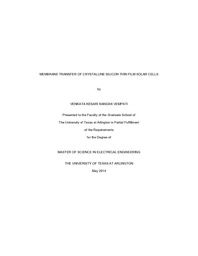
ATTENTION: The works hosted here are being migrated to a new repository that will consolidate resources, improve discoverability, and better show UTA's research impact on the global community. We will update authors as the migration progresses. Please see MavMatrix for more information.
Show simple item record
| dc.contributor.author | Vempati, Venkata Kesari Nandan | en_US |
| dc.date.accessioned | 2014-07-14T20:19:39Z | |
| dc.date.available | 2014-07-14T20:19:39Z | |
| dc.date.issued | 2014-07-14 | |
| dc.date.submitted | January 2014 | en_US |
| dc.identifier.other | DISS-12701 | en_US |
| dc.identifier.uri | http://hdl.handle.net/10106/24378 | |
| dc.description.abstract | Silicon has been dominating the solar industry for many years and has been touted as the gold standard of the photovoltaic world. The factors for its dominance: government subsidies and ease of processing. Silicon holds close to 90% of the market share in the material being used for solar cell production. Of which 14% belongs to single-crystalline Silicon. Although 24% efficient bulk crystalline solar cells have been reported, the industry has been looking for thin film alternatives to reduce the cost of production. Moreover with the new avenues like flexible consumer electronics opening up, there is a need to introduce the flexibility into the solar cells. Thin film films make up for their inefficiency keeping their mechanical properties intact by incorporating Anti- reflective schemes such as surface texturing, textured back reflectors and low reflective surfaces. This thesis investigates the possibility of using thin film crystalline Silicon for fabricating solar cells and has demonstrated a low cost and energy efficient way for fabricating 2µm thick single crystalline Silicon solar cells with an efficiency of 0.7% and fill factor of 35%. | en_US |
| dc.description.sponsorship | Zhou, Weidong | en_US |
| dc.language.iso | en | en_US |
| dc.publisher | Electrical Engineering | en_US |
| dc.title | Membrane Transfer Of Crystalline Silicon Solar Cells | en_US |
| dc.type | M.S. | en_US |
| dc.contributor.committeeChair | Zhou, Weidong | en_US |
| dc.degree.department | Electrical Engineering | en_US |
| dc.degree.discipline | Electrical Engineering | en_US |
| dc.degree.grantor | University of Texas at Arlington | en_US |
| dc.degree.level | masters | en_US |
| dc.degree.name | M.S. | en_US |
Files in this item
- Name:
- Vempati_uta_2502M_12701.pdf
- Size:
- 2.705Mb
- Format:
- PDF
This item appears in the following Collection(s)
Show simple item record


